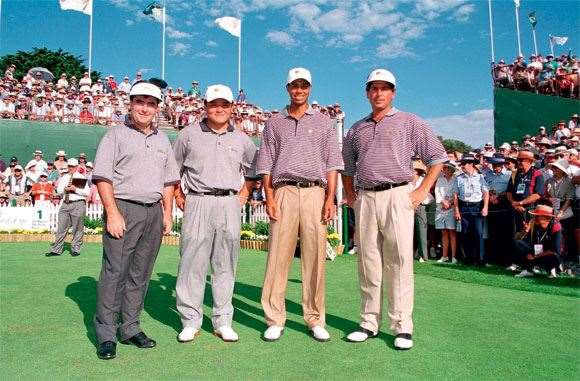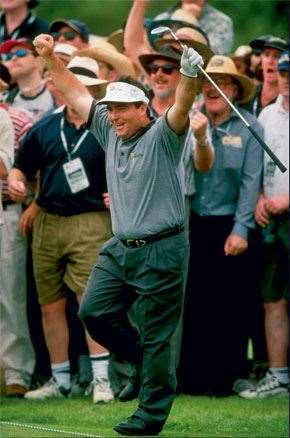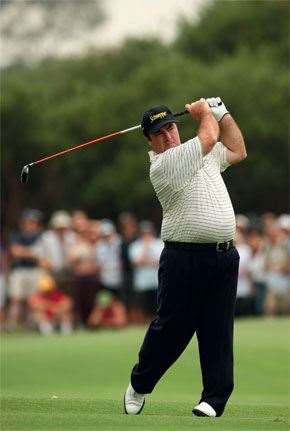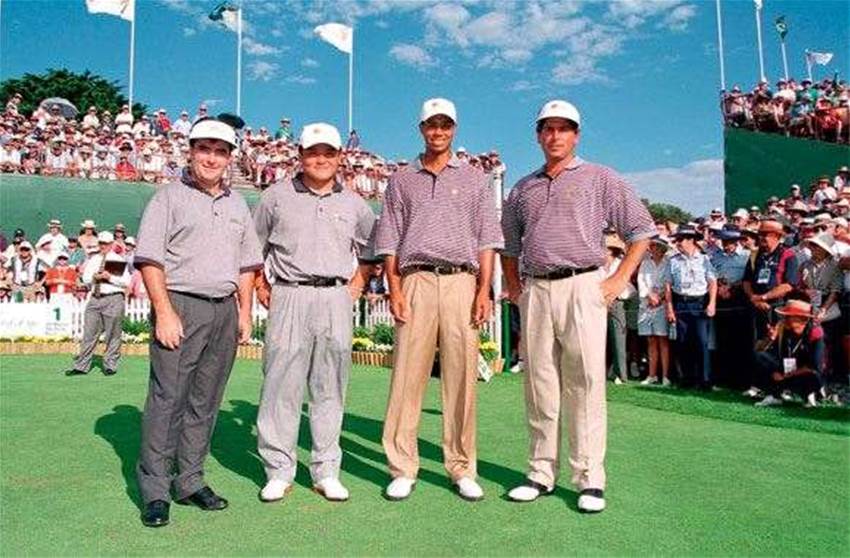For the man known as “Pazz”, the ’98 Cup ranks with career high points that include 23 career victories worldwide and every significant title in Australian golf,
For the man known as “Pazz”, the ’98 Cup ranks with career high points that include 23 career victories worldwide and every significant title in Australian golf,
It was the defining moment of the 1998 Presidents Cup at Royal Melbourne. The odd-couple pairing of Craig Parry and Shigeki Maruyama was pitted against the power duo of Tiger Woods and Fred Couples – a metaphorical stand-in for the Internationals’ underdog status against a strong United States line-up. But the mix of Southern Hemisphere soil and good feeling had given the rest-of-the-worlders a boost, taking a commanding lead after the opening set of matches on Friday. In the early session on Saturday, Parry and Maruyama were a hole down to the Americans on the 17th, but the ebullient Japanese pro holed a long putt to draw level. Going up the last, it looked to be “advantage USA” as the International pair was off the green, but Parry proceeded to hole out a 20-metre chip to take the match. Even with half the event left to play, it was the ultimate signal the tournament was fated for the Internationals.
 Photos by Getty Images
Photos by Getty ImagesFor the man known as “Pazz”, the ’98 Cup ranks with career high points that include 23 career victories worldwide and every significant title in Australian golf, including the last professional tour event held at Royal Melbourne, the 2005 Heineken Classic. While the 45-year-old has scaled back his playing schedule internationally, he remains an active competitor and will tee it up in the local events again this summer.
And, yes, he’ll be at Royal Melbourne, as a fan, hoping to cheer on an International victory – which would be the first since the event was last held in Australia.
Does it surprise you that, 13 years later, the side you were a part of remains the only winning International team in the Presidents Cup’s history?
You would think, with the teams we’ve had over the years, that we’d have won it again by now. Obviously the Americans are tough to beat and they’re extremely good players. I would’ve thought though, going back to Royal Melbourne, that our guys have a pretty good chance of winning the Cup again this year.
Do you have a theory for the Internationals’ lack of success?
The [Americans] do have an advantage of playing the Ryder Cup every other year, so they’re used to playing four-ball and foursomes, team golf, where our guys only get to play it every couple of years.
You played in the 1994, ’96 and ’98 Presidents Cups – the first decisive for the US, the second very close, then decisive for the Internationals. Do you recall big differences in the lead-up or during tournament week?
Not really. We were all excited to play the first one because it was like a Ryder Cup format. The majority of the players were on the [US] PGA Tour, so we were playing a golf course we were used to. David Graham was the captain; it was a good week, there was nothing wrong, they just played better.
The second one, with Peter Thomson as captain, was a lot of fun. We had a very good team, we got very close. Obviously with the one in Melbourne, everyone just gelled really well as a team.
The issue that’s always brought up with the Internationals is having to assemble a team of guys from all these different countries and cultures. You partnered the likes of Maruyama and Paraguayan Carlos Franco in your Cup career – what are your thoughts on trying to pull all the cultures of the International team together?
We do come from different countries, but we have the one thing that’s very common – we’re all overseas playing golf; we all become very good mates in the end.
It’s part of the legend of the ’98 Cup that you helped guide Shigeki around Royal – he played very well, of course, won all his matches. How much truth is there to that? Was there a chemistry at work there or was it just a matter of the two playing well at the same time?
I’d known him for years and played quite a bit in Japan; it did help out. I spoke enough Japanese to get by and he spoke enough English to get by as well. I’d been playing in Japan since 1988, had been going there every year at least once and had played there with Shigeki and Joe and Jumbo Ozaki.
Pros get used to the practice of playing stroke play events week in, week out. For that one week, playing match play, and with a partner as well, does that require a real adjustment?
I think it does. You can’t be as aggressive with the shot because you need to set up for your partner. If you keep it in play all the time, drive the ball in play, and the other team mis-hits a few drives, all of sudden you’re going to win those holes. And because you’re only playing 18 holes of match play, it’s not like 72 where you can come back from a couple of bad holes. If you have a couple of those in match play, it’s difficult to get it back. It’s “keep it in play at all costs” – you don’t want to give the opposition an easy hole.
The knock on the Presidents Cup is that it doesn’t quite inspire the passion that the Ryder does. You have significant career highlights in the Presidents Cup, but where does it rate compared to your other accomplishments in the game?
The Presidents Cup is the ultimate for international players, because it’s the only team event we play. It’s a good, fun event to play in as well, it’s not like it’s a boring week. The gallery makes it a lot of fun, the players make it fun. All up it’s a good week and at the end of your career you look back and think it was great to do.
The chip-in against Tiger Woods and Fred Couples – can you put that in context?
 Photos By Getty Images
Photos By Getty ImagesI don’t want to say it was the turning point of what happened in the Presidents Cup in ’98, but it more or less was. We were looking like we were going to lose that game, and then all of a sudden we turned it into a win. Then another couple of guys behind us turned their game around as well, and we’re on top, and the Americans are shell-shocked.
It’s one of those moments in Australian golfing history, I suppose, that everyone remembers. Not only because it was just a chip-in to win the game, but it was the best player in the world, the calibre of the player that Shigeki and I were up against. You got two guys who probably shouldn’t have any chance of beating Tiger and Fred, and we walk away with the point. That’s probably what turned around, what it meant to the team. It probably is one of the best moments that I’ve had in team golf.
How much did Royal Melbourne contribute to the victory? And is experience in playing the course a factor to playing it well?
Absolutely ‒ it’s a huge factor. It’s the best golf course in Australia; unique, everyone can go and play it, members play it, we can play the Presidents Cup and have a great competition on it. It’s the ultimate golf course.It’s a great advantage to have. It’s the different forecasts you have – if you have a hot forecast, you know it’s going to be northerly winds. If you have a cold forecast, you know it’s going to be from the south-east or coming in off the bay.
It’s not such a big advantage to hit short irons everywhere, because the wind conditions will dictate what actually happens and what line you pick. If these guys aren’t used to picking the right line off the tee, there’s no way in the world they’re going to beat us.The last time around Melbourne, as it’s famous for, gave us every kind of weather: incredibly hot on day one, freezing by the end.
That was what set up our advantage, because the Americans didn’t know what clubs to hit off the tee. I remember playing against Scott Hoch, and they were on one tee, and the weather had changed direction and come in from a different area. They were picking the wrong line with the wrong club; they weren’t used to playing in those conditions. I told Shigeki, “Okay, we have to go on this line here with a certain club.” He’d look at me like as if to say, “You’ve got to be kidding.” And the shot would turn out really well, and he realised there’s a big advantage.
You Tour golfers seem to be so used to being dependent on yourselves, it seems the biggest thing you get out of these events is being in a team environment. Do you have a team room memory you recall fondly?
One I do remember is where the players were all sitting around in the International room before going out to play a practice round. Peter Thomson was telling us a story about how he had borrowed a set of golf clubs and won a British Open – and then had to give the golf clubs back! You had all the different players on our team flabbergasted that he won a British Open and had to give the clubs back. There’s no way in the world that would ever happen today ...
I have to ask: you’re a friend of Tiger Woods – what do you think we’ll see from him?
He’s played there in the past, he loves the golf course. I think he’s going to play extremely well. Anyone who gets a point off Tiger is going to have played really well himself to beat him.
Is Tiger far away from being “back”?
If he says he’s not far away from playing good, I’d believe him. He’s the greatest talent to ever play the game; I’m sure he’ll come back and play extremely well again. It depends on what his motives are for playing well and what he wants to do. It’s really up to him.
You’ve had him as a team-mate playing for Isleworth in the Tavistock Cup [an interclub competition in Florida]. What’s he like as a playing partner?
He’s fantastic. Mate, he hit some unbelievable shots; he’s probably hit the best shot I’ve ever seen anyone play on the 18th hole at Isleworth. It was a wedge that hooked maybe 50m around a tree, under branches, run along the ground, then sliced and went to about three and a half metres. With a wedge! Not many people on the planet could have hit that shot.
You’ll be in the field at the NSW PGA Championship, as will rugby league star Braith Anasta. Being a Bulldogs fan, I’m sure you’ll answer this objectively, but what do you think Anasta will learn being out there with you guys?
I think he’ll learn we play on tougher golf courses than the majority of people are used to. The flag placements are little bit tougher than normal, the greens get a little bit quicker. I’m sure if he has a good day out, and he enjoys his time, hopefully he makes the cut.
Does being a professional athlete in another sport help him, or will he be as out of his element as anyone else?
There’s not too many sportsmen from other fields who have ever played professional golf at the highest level as well. Scotty Draper played professional tennis and had a couple of years in the PGA in Australia. It’s totally different; professional sportsman in another field and then playing on the tour, or in a tournament. Nigel Mansell
tried to do it and he struggled with it ...
It doesn’t mean they’re bad golfers, it’s just that they’re not professionals. You’re competing with people who have played for many, many years and have honed their skills. Makes it very difficult ...
 Images By Getty Images
Images By Getty ImagesWhere are you at with your game? This is shaping as an exciting summer for Australian golf, with the other tournaments benefitting from the flow-on effect of the Presidents Cup ...
I’ve only played one tournament overseas this year ‒ Thailand a few weeks ago. I’ll have four, five weeks’ practice to get ready for the tournaments, so I’ll start to do that soon. I feel as though I’m playing all right, it’s just a matter of, if I do enough practice and get my game ready, hopefully playing well through the summer.
How are you approaching your golf over the next few years? Do you have any interest in Seniors Tour/Champions Tour down the line?
At the moment it doesn’t interest me. I’ve still got four, four and a half years to go before I have to worry about the Senior Tour. At the moment I’m not focused on that part of playing golf. I’ve had a reasonably relaxing year – I don’t see getting on planes and going overseas as all that much fun these days I’m happy to stay at home for most of the year.
– Jeff Centenera
Related Articles

Japanese star battles his way to Hero-ic win in Bahamas

Under the radar into contention: Si Woo’s scintillating Australian Open Saturday













